 CHRISTIAN SYMBOLOGY
CHRISTIAN SYMBOLOGY
Enjoy the site? Click here to buy the paperback book ($24.99) or PDF book ($9.99)!
© 2001-2025 by Doug Gray. All Rights Reserved.
 CHRISTIAN SYMBOLOGY
CHRISTIAN SYMBOLOGY
Enjoy the site? Click here to buy the paperback book ($24.99) or PDF book ($9.99)!
© 2001-2025 by Doug Gray. All Rights Reserved.
The cross on which Jesus our Lord and Savior died for our sins is the most commonly recognized and most universally accepted symbol for Christianity the world over. It symbolizes God’s great sacrifice, an offer of salvation to all of humanity and the promise of the Resurrection.
There are three different styles of crosses Jesus might have died upon. Scholars are not completely sure as to which style it was. The first style is the Tau cross. It is in the shape of a “T”. The second style is referred to as the Latin cross. This cross is the most popular representation of the cross today and most likely the form Jesus died upon. The final style is the Y-shaped cross. This cross is not as popular as the first two, but still an option.
Tradition tells us that the cross our Savior died upon was made of four different types of wood. The four types of wood where chosen by the Jews for their lasting properties, so that Jesus might hang on the cross forever. The footrest of the cross was made of cedar for its durability and resistance to rotting. Other woods used were the cypress, for its pleasant aroma that would offset the stench of death, the palm, a symbol of victory and olive wood for the inscription, a symbol of the peace that would follow after Jesus was dead.
During the early days of the church, the cross as a Christian symbol was rarely used. Believers did not want to think about their Savior’s death. It was, after all, the instrument upon which He died.
In the year 325 A.D. Constantine the Great conquered the Roman Empire and made Christianity its main religion. Christians no longer had to hide from the authorities or suffer grusome deaths for their faith. As peace spread throughout the empire, the popularity of the cross as a Christian symbol spread with it.
The cross of Jesus was supposedly found by Constantine’s mother, Helena, on May 3, 328 A.D. Tradition tells us it was buried deep underground where it was found with the other two crosses. Jesus’ cross was easily separated from the others when a woman who was sick touched one of the crosses and was instantly healed. Today the location of these crosses is unknown.
Crosses fall into two major categories: the Greek (equal length arms) or Latin (shorter cross bar raised above the center). All crosses are variants of these two forms and quite a few variations there are indeed. F. R. Webber estimates that there are 400 different forms of the cross, with 50 of them playing a prominent part in the decoration of our churches and parishes. The main reason for so many cross variations was the use of the cross in heraldry. Heraldry was the art of creating and displaying coats of arms during the Middle Ages. Each knight wearing armor of similar make and style could not distinguish friend from foe. Cross variations were adopted by each knight to be worn on their person for easier identification. The majority of crosses in this chapter are taken from heraldry. It should be noted that there is a bit of confusion regarding such crosses. Erroneous records and various spellings have lead to a great deal of confusion over the identities of some crosses. The author has done his best to list each cross accurately.
Besides heraldry, crosses have been used in all sorts of ways. They have accompanied names on contracts to show the trustworthiness of the deal. They were placed in market places to remind merchants to treat their customers fairly. Crosses have been used as floor plans for churches and scratched or painted on the walls of churches to keep evil spirits at bay. They have most noticeably been used to mark the graves of those who claimed the promise of eternal life in Christ.

THE CROSS ADORNED – A cross that is decorated with lilies or floral arrangements. This form of cross is very popular during Easter celebrations.

THE CROSS AIGUISÉE (Equisée, Urdée) – A cross with square endings and triangular caps. It symbolizes the suffering (passion) of our Lord.

THE CROSS ALISÉE PATÉE (Alaisée, Alesée, Global Patée) – This is a variation of the Cross Alisée. The outside edges of the cross conform to a circular shape.

THE ANCHOR CROSS – 1. A cross in the form of an anchor. It symbolizes hope and stability in Jesus. The anchor cross is an ancient Christian symbol, dating back to the 2nd century. It was frequently used in the catacombs to decorate the tombs of the dead. Because it was illegal to practice Christianity in the Roman Empire, symbols used in the catacombs were frequently of common objects (anchor, shepherd, dove, etc.) that could hold double meanings. In this way the symbol would not look blatantly Christian, concealing its Christian meaning from all but the informed few.
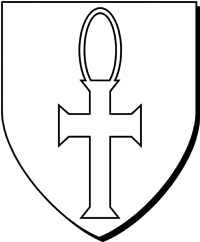
THE CROSS ANKH (Crux Ansata) – A Latin or Tau cross with a loop extending from the top. It symbolizes life. The cross is said to be of ancient Egyptian origin.

THE CROSS AVELLANE (Avellaine) – A decorative cross that derives it’s appearance from the husks of the plant Corylus avellana or hazelnut.
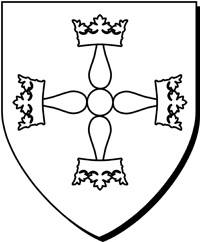
THE CROSS BANISTER - A cross composed of four banister-staves joined in the middle with a king’s crown at each end.

THE CROSS BARBÉE (Barby, Barbed) – A Greek style cross with designs like arrows on its tips. The arrows represent barbs found on fish hooks. The cross symbolizes being fishers of men.
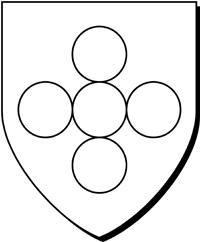
THE CROSS BEZANT (Bezantée, Bezanty, Cross of Bezants) – A cross formed by connecting circles. The cross can either be of five (Greek form) or seven (Latin form) circles.
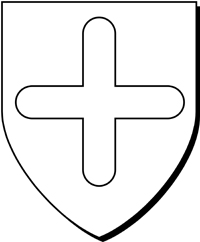
THE BLUNTED CROSS (Moussue) - A greek cross with blunted (rounded) ends.

THE CROSS BOTTONNÉE (Bottony, Bourbonée, Trefflée) – A cross, either Latin or Greek form, with trefoils at the end of each arm. A strikingly beautiful form of the cross, it has been used frequently as decoration in churches. One popular use of this cross is on the cover of hymn books.
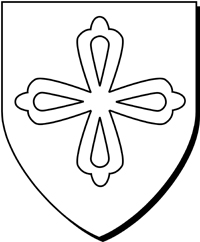
THE CROSS BOTTONNÉE PATTÉE - A more decorative form of the Bottonnée style of cross.

THE CROSS BRETISSÉE – A cross with indents similar to embattlements found on forts. The difference with this cross versus the cross embattled is that the ridges are staggered opposite each other. It symbolizes Christian warfare and the church militant.

THE CROSS CABLÉE (Cabled) – A decorative cross formed by combining two twisted ship cables. This is not to be confused with the corded cross.

THE CANTERBURY CROSS – A cross made of four hammer- like arms extending from a central square.

THE CROSS CAPITAL (Cross Chapiteau) – A decorative cross formed from the capitals found on architectural columns.
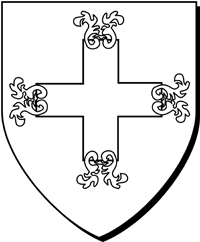
THE CROSS CATOOSED - A cross with a bracket (catoose) on each end. The brackets resemble foliage leaves.

THE CELTIC CROSS (Irish Cross, Cross of Iona) – 1. A very ancient form of the cross used by Christians in Great Britain, Ireland and surrounding areas. These crosses are often highly ornate with intricate carvings throughout. The carvings are usually of the crucifixion. The distinguishing element of the Celtic cross is the circle added to it. The circle represents eternity. 2. At one point during the Protestant movement, the Celtic cross was used as a substitute for the Latin cross to distance Protestants from the Roman Catholic Church. 3. The cross can be called the cross of Iona because it is there that missionaries first gained a foothold in the British Isles.

THE CROSS CERCELÉE – A decorative cross that is similar to the cross moline but with more pronounced, curved edges.
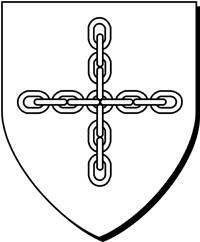
THE CHAIN CROSS – A cross formed from two crossed chains. Sometimes the chain links are square. This cross symbolizes the power of the cross to free Christians from the chains (bondage) of sin.
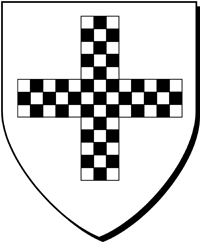
THE CROSS CHEQUY (Chequey, Chequered, Echiquette) – A cross made up of three rows of squares (checkers) with each square alternating in color.

THE CROSS CLECHÉE – A decorative cross with ends like spear tips. The tips are actually rounded off in loops. Inside the cross is a second cross that is smaller and the same color as the background field. This cross may be found in both Latin and Greek forms.
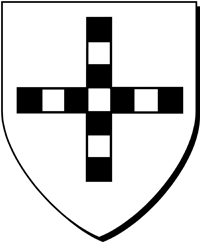
THE CROSS COMPONY (Componée, Gobony) - Similiar to the cross componee and Chequy but with only a single row of squares.
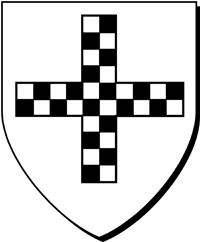
THE CROSS COUNTER COMPONY (Counter Componée) – A cross formed from smaller rows of different colored squares.

THE CROSS OF CONSTANTINE – A cross combined with the Chi Rho symbol. It was this sign that Costantine saw in the sky when he was told by God, “In this sign, conquer.”

THE COPTIC CROSS - A cross adopted by the Egyptian/Ethiopian Coptic and Gnostic churches. It was influenced by the Egyptian Ankh Cross. The circle stands for God’s everlasting love through the sacrifice of His Son on the cross.
The modern coptic cross is made up of a cross with three points on each end symbolizing the Trinity. When all of the points are added up, there are twelve. These twelve points symbolize the Apostles who spread the Gospel message. The message around the cross is the monogram Ihs, meaning Jesus.
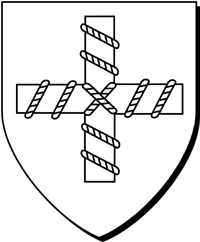
THE CROSS CORDÉE (Corded) – A Latin or Greek cross with a cord wrapped around it. It symbolizes the binding of Jesus at His trial and crucifixion.

THE CROSS COTISED (Coticed, Cotized) – A cross that has ribbons or strips added to the cross. The ribbons symbolize the four Gospels.

THE CROSS CRAMPONÉ - A cross very similar to the cross cramponnée. This cross is formed by combining two cramps or crampoons.

THE CROSS CRAMPONÉE – A cross potent without the left part of each arm. This cross is similar to the swastika. The only difference is in its shorter right-turning arms.

THE CROSS CRESCENTED (Cressanted, Croisant, Cressanty) – A cross with crescents endings.

THE CROSS CROSSLET (Recrossed, Crenellée) – This cross is formed by putting four Latin crosses together. It symbolizes taking Christianity to all four corners of the earth.
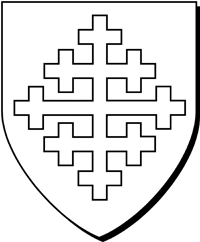
THE CROSS CROSSLET CROSSED - This is a variation of the crosslet. It has the upper and lower limb crossed again, and the transverse piece recrossed on each side.

THE CROSS CROSSLET DOUBLE CROSSED (cross crosslet crossly) - This is another variation of the crosslet. Each arm of the cross consists of a crosslet.

THE CROSS CROSSLET IN SALTIER (Saltire couped, St. Julian) - A crosslet turned 45º. This cross is connected with St. Julian.

THE CROSS AND CROWN – A Latin cross with a king’s crown resting on top of it symbolizes eternal life. The crown should always be perfectly horizontal, and not leaning to either side.

THE CROSS AND CROWN OF THORNS – A Latin cross with a crown of thorns resting upon it symbolizes the suffering (passion) of our Lord on the cross. This cross is frequently seen on the altar, pulpit vestments and banners during Good Friday celebrations.

THE CROSS CROWNED (Coronetted, Coronated, Crownated) - A cross formed with crowns on each end.
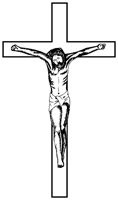
THE CRUCIFIX – A cross with Jesus on it. It is a symbol of the passion of our Lord. Due to the sensitive nature of our Lord’s brutle death on the cross, the early church substituted Jesus’ human figure on the cross with a bleeding lamb. It would be the Council at Constantinople in 692 that would order the actual figure of Jesus replace the symbolic forms. From then on the crucifix rose quickly in popularity. Opinions vary as to how realistic our Lord should appear on the cross. Artists should give special consideration to the sensitivities of their audiences.

THE CROSS DANCETTE – A decorative cross closely resembling the indented cross, but with fewer and larger teeth.

THE CROSS DEMI-SARCELLED – This decorative variation of the cross patée has square indentations on the end of each arm.

THE CROSS DOUBLE-FITCHÉE (Chappée) – This decorative cross has indented triangles on each end.
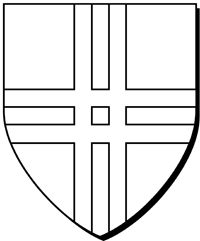
THE CROSS DOUBLE-PARTED – This cross is identical to the interlaced cross, but without the intertwining.

THE CROSS DOUBLE PARTED FLORY - A double parted cross ending in pointed, petal like shapes.
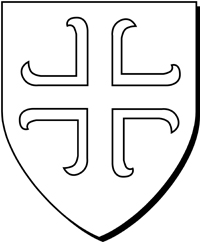
THE CROSS DOUBLE PARTED VOIDED (Disjointed) - A doube parted cross broken into four pieces by a void.

THE CROSS DOVETAILED – A decorative cross with side indentations resembling the dovetail joints made by cabinet-makers.
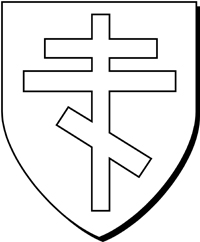
THE EASTERN CROSS (Slavic, Russian) – This cross is the official cross of the Eastern Orthodox Church. It is placed on the top of their spires and should not be used by any other church. It is formed by two horizontal arms and a third, slanting arm. The top arm represents the inscription placed above Jesus’ head. The bottom bar is based on Eastern teachings that when Jesus was crucified, His feet were nailed apart, not placed together as the Protestant and Roman Catholic Churches teach. As to why the bar is slanted, most agree this is to symbolize the cross saltire (St. Andrew’s cross). Tradition speaks of St. Andrew being the first missionary to take the gospel message to the Russian people.

THE CROSS EMBATTLED (Crenellée) – A cross with indents similar to embattlements found on forts. The difference with this cross versus the cross bretissée is that the ridges are directly opposite each other. It symbolizes Christian warfare and the church militant.
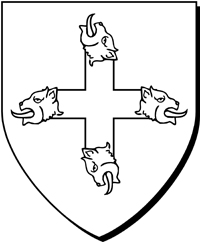
THE CROSS ENGOULÉE – A very unique form of the cross in which the ends of the cross transform into lions heads. This cross is rarely used.

THE CROSS ENGRAILED – The edges of this cross are pointed, much like thorns. It symbolizes the painful suffering of Jesus on the cross.

THE CROSS ENTRAILED – A decorative form of the cross similar to the cross clechée. The only difference is the loops at the ends are more distinct.

THE CROSS ERMINÉE (Four Ermine Spots) – A form of the cross made from four ermine spots. This cross is very popular in embroidery.

THE CROSS ETOILE – A cross made up of four rays in the shape of a star. This cross is similar to the cross fitchée.
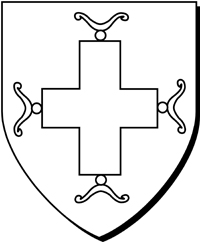
THE CROSS FER-DE-FOURCHETTE – A decorative cross. The name fer de fourchette means “forked iron” referring to the gun rests that soldiers once used to rest their guns upon.

THE CROSS FERRATED - A cross with horseshoes on each end. The word ferrated is from the Latin word ferreus, meaning “shoed with iron”.
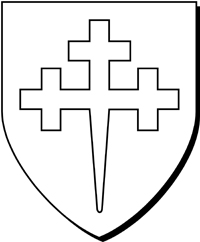
THE CROSS FITCHÉE – Any cross with a pointed lower end. Tradition tells us that such a cross developed during the Crusades. The crusaders developed the cross so it could be easily driven into the ground for daily devotions.
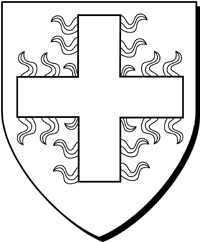
THE CROSS FLAMANT – This unique cross has flames coming from its arms, its center, or both. It symbolizes religious zeal.
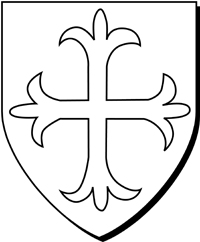
THE CROSS FLEUR-DE-LYS – A cross with fleurs-de-lys on the end of each arm. This cross symbolizes the Trinity.

THE CROSS FLEURETTÉE – This cross symbolizes the Trinity. It is often used as decoration during Trinitarian season. It is similar to the cross fleurie except with smaller flower petals.

THE CROSS FLEURIE – This decorative cross, either Latin or Greek, has ends like flower petals. This cross symbolizes the Trinity.
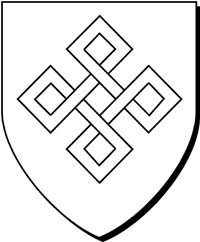
THE CROSS FRETTED – A decorative cross of interwoven squares forming five symmetric squares.
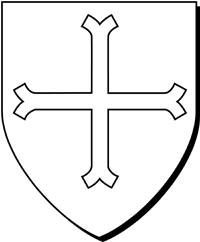
THE CROSS FURCHÉE – This decorative form of the cross appears to have had the tips of its edges cut off. The word furchee means “forked”.
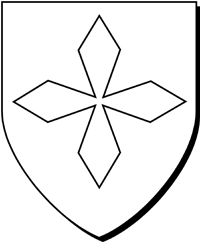
THE CROSS FUSIL (Fusilée) - A cross made up of four diamonds.
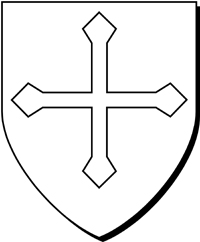
THE CROSS WITH FUSIL TIPS – This cross is composed of a diamond on the end of each arm.

THE CROSS FUSILY - A cross composed of any number of diamonds.
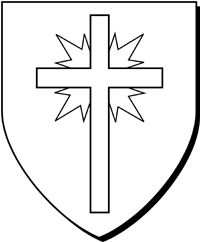
THE CROSS OF GLORY (Rayed, Easter) – A Latin cross with twelve or more rays of light behind it. It symbolizes the Resurrection and is appropriate for the Easter celebration. See image on p. 81.
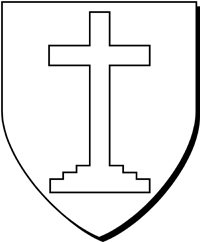
THE GRADED CROSS – This cross is composed of a Latin cross set atop three steps representing the three virtues. The lowest step represents charity, upon which the other virtues are based. The second step represents hope. The third step is faith. It should not be a surprise that this step is closest to the cross.1
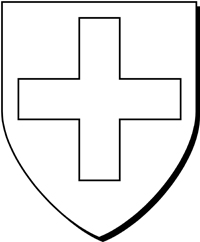
THE GREEK CROSS (Calvary Cross) – This cross is formed from arms of equal length. On some altars five Greek crosses are seen. Four small crosses are found on each corner of the altar. A larger Greek cross is placed in the center, where the sacraments are placed. These five crosses symbolize the five wounds of Jesus.
The cross was a popular design for the floor plans of churches. At first, the Greek cross and Latin cross were used indiscriminately by the early churches. As the East and West pulled apart, so did the churches. The western, or Roman Catholic Church, would start using the Latin cross as the floor plan, while the Eastern Orthodox would use the Greek cross as the floor plan.

THE CROSS GRINGOLÉE – This cross is formed with each arm transforming into serpent’s heads. It is symbolic of sin and salvation.
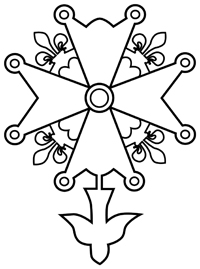
THE HUGUENOT CROSS - The cross was developed by the French Protestant Huguenots (confederates) during their conflicts with Roman Catholicism during the seventeenth century. 1. The cross is based on the maltese cross which is made up of four triangles joining at the center. The four triangles symbolize the four Gospels. Each triangle has two circles affixed to the corners for a total of eight. They symbolize the eight Beatitudes found in Matthew 5: 3-10. Connecting the four arms of the cross are four Fleur-de-Lys. The Fleur-de-Lys symbolize the Trinity. When the flower’s petals are added up they total twelve. The twelve symbolize the Apostles. Hanging below the cross is a descending dove. It symbolizes the Holy Spirit. 2. Today the cross is a symbol of the Reformed Church of France.

THE CROSS INDENTED – A cross with its edges similar to that of a saw’s edge.

THE CROSS INTERLACED (Parted and Fretted) – A decorative cross composed of four independent strands woven together in the center.

THE CROSS INVECTED – A cross similar to the cross indented, only the points are rounded.

THE CROSS INVERTED – An upside down cross symbolizes both St. Peter and St. Jude who were crucified upside down.
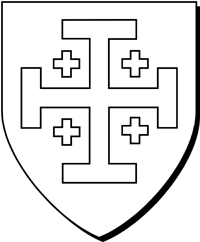
THE JERUSALEM CROSS (Crusader’s, Cantonnée) – 1. A cross potent (constructed from four tau crosses) surrounded by four Greek crosses. It was used on the coat of arms of the Latin Kingdom of Jerusalem (A.D. 1099-1203). The four Greek crosses represent the four Gospels taking the place of the Mosaic law symbolized by the tau crosses. 2. Some scholars believe the large cross represents the spear wound in Jesus’ side, while the four small crosses represent the four wounds Jesus received in his hands and feet. 3. The cross can symbolize missionary work where the main cross symbolizes the church and the four Greek crosses the four corners of the earth.
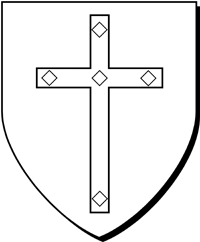
THE JEWELED CROSS – A Latin cross inset with five red jewels. Each jewel symbolizes one of the five wounds Jesus received on the cross.

THE CROSS LAMBEAU – This cross is formed by taking a cross patée and adding a base with three pendant labels protruding from the base.
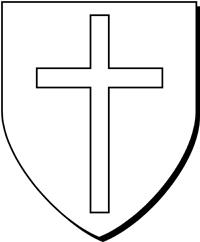
LATIN CROSS (Calvary, Immissa) – 1. This cross is most likely the form of cross upon which Jesus died. It is universally accepted in all churches who confess that Jesus Christ is Lord and that His atoning work on the cross is essential to salvation. The cross, being empty, symbolizes the Resurrection. The empty Latin cross is often seen held in the hands of Jesus after being raised from the dead. 2. The cross was a popular design for the floor plans of churches. At first, the Greek cross and Latin cross were used indiscriminately by the early churches. When the Eastern and Western churches split, so did church design. The West, or Roman Catholic Church, would start using the Latin cross as the floor plan, while the East, or Eastern Orthodox Church, would use the Greek cross as the floor plan.
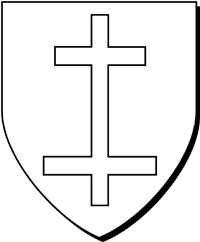
THE CROSS OF LORRAINE – A cross that is formed with two cross bars. It is similar to the patriarchal cross, except that the longer bar is closer to the base.
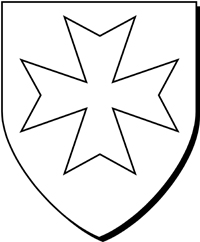
THE MALTESE CROSS (Eight-Pointed, Regeneration) – 1. This cross is made up of four solid spear tips. The eight outer points are equidistant from one other, symbolizing the eight Beatitudes. The cross gets its name from the Island of Malta, where it was the symbol of the Knights Hospitallers, led by St. John of Jerusalem. The knights protected pilgrims on their journey to the Church of the Holy Sepulcher (the site of Jesus’ crucifixion and burial) in Jerusalem. 2. It is called the regeneration cross because it symbolizes new birth.

THE CROSS MASCLE – A decorative cross made up of what looks like meshwork.

THE CROSS MASCLE POMMETTÉE – This decorative mascle cross has circles on each of its twelve points.

THE CROSS MILLRINE – This is a cross with ends that resemble the iron placed in the center of the millstone.

THE CROSS MOLINE (Ancrée) – This decorative cross developed from the millrine cross. It’s ends are gently curved resembling flower petals.

THE CROSS NEBULÉE – This is a cross with rounded fins on each arm.

THE CROSS NOWY – Any cross with a circle at its center.

THE CROSS PALL – This cross is similar to the tau cross with it’s “Y” shaped arms. The cross dates back to the catacombs where it is occasionally seen.
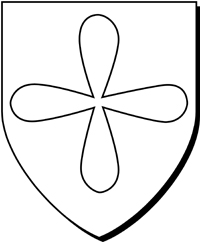
THE CROSS PANDAL (Pandell, Pendal, Spindle) – A cross made up of four ovals or spindles.
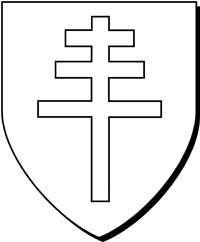
THE PAPAL CROSS – A cross made up of three cross bars. The older form of the cross has the longest bar in the middle of the cross. The newer form has each bar shorter than the one beneath. This cross is specifically assigned to the Roman Catholic pope and is frequently seen proceeding him during processionals. It must NEVER be used by any other church or organization for any reason.
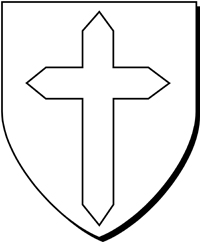
THE PASSION CROSS (Champain, Pointed, Urdée) – 1. A Latin cross with pointed ends. It symbolizes the sufferings (passion) of our Lord on the cross. 2. If the cross is displayed arising from a chalice/cup, it is a symbol of our Lord’s sufferings in the Garden of Gethsemane. 3. The cross can be used as a symbol for Maundy Thursday and Good Friday services.

THE CROSS PATÉE (Formée) – A cross made up of four arms that curve outward to a straight edge. It is one of the most popular decorative crosses.
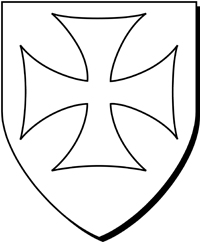
THE CROSS PATÉE BLEMISHED (Concaved) - A cross identical to the cross patée but with curved ends.
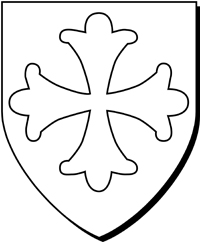
THE CROSS PATÉE BOTONNÉE (Toulouse) - A cross patée with the tips of the cross ending in rounded, floural endings.

THE CROSS PATÉE CRENELLÉE - A patée cross with square indentations on each arm.
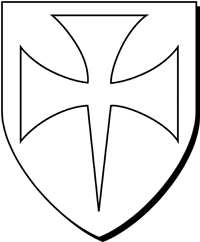
THE CROSS PATÉE FITCHÉE - A patée cross with a spike for the lower arm.
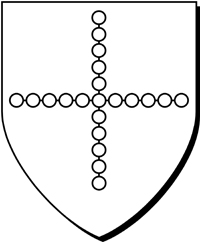
THE PATERNOSTER CROSS – This cross is made up of attached circles or beads and is symbolic of prayer.
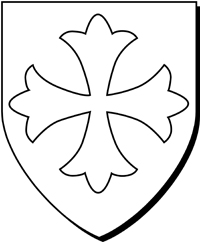
THE CROSS PATONCE – A decorative cross similar to the cross fleurie, except that it has wider arms. It is a favorite among church decorators and is frequently used.
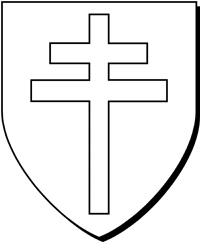
THE PATRIARCHAL CROSS (Portante) – 1. A cross with two cross beams, the top beam shorter than the lower beam. The upper beam represents the sign placed over Jesus’ head. In paintings and stained glass windows, the patriarchal cross is often being carried by the various patriarchs. 2. The cross is a symbol of the Apostles Peter and Philip and is seen being carried by them in various illustrations. 3. While the papal cross is used for the pope, the patriarchal cross can be used for cardinals and archbishops.

THE CROSS OF FOUR PHEONS A cross made up of four touching dart heads. It is symbolic of the fiery darts thrown at us by our enemies. The darts are defeated by the power of the cross.

THE CROSS POMMÉE (Bourdonée) – This cross has knobs like a palmer’s staff on each end.
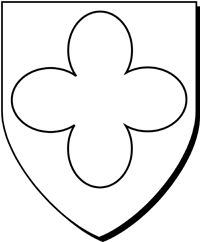
THE CROSS OF FOUR POMELS (Quatrefoil) - A cross made up of four pommels.
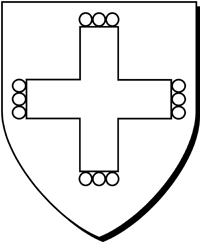
THE CROSS POMMELLÉE – This is a cross like the cross pommeé only with two or three knobs on the end of each arm.

THE CROSS PORTATE – The name of a cross tilted at an angle. It symbolizes the cross carried by Jesus. However, it is not clear how this cross is used, as all crosses are always to stand upright or inverted.
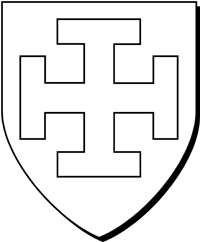
THE CROSS POTENT – This cross is made up of four tau crosses. Because the cross ends look like crutches, the cross symbolizes the power of Jesus to heal sickness and disease.
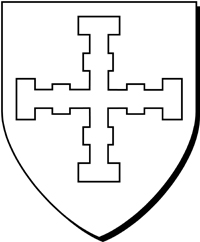
THE CROSS POTENT GEMELL - A cross so called because of the doubling of the crutches, or potents, on each end.
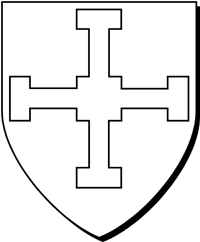
THE CROSS POTENT QUADRATE (Cross of St. Chad) – This cross is formed by combining a cross potent and a cross quadrate.

THE CROSS QUADRATE – A cross with a square at its center.

THE CROSS RAGULÉE (Knotted Cross) – This cross has slanted fins on each arm. The fins seem to suggest limbs that have been cut off.
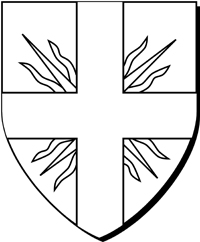
THE CROSS RAYONÉE – A cross with rays, or even flames, proceeding from the center of it.
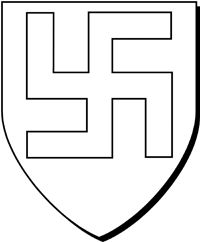
THE CROSS REBATED (Swastika, Fylfot, Gammata) – 1. This is a Greek cross with arms that are bent at right angles. It is a very ancient form of the cross. In pre-Christian times, it symbolized sun-worship and fire. “In all probability, there is a direct connection between promatha and the Greek fable of Prometheus. The swastika was used in the catacombs, by the early Christians, doubtless with reference to Christ as ‘the Sun of Righteousness’.”3 2. It was thought that the cross symbolized the four cardinal points on a compass. 3. Due to the cross’ connection to the German Nazi party and the great evils the Nazis committed, this cross should no longer be used in the church.
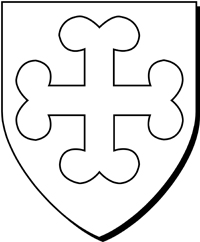
THE CROSS RECERCELÉE – This is a cross very similar to the cross moline in shape, except that its ends are rounded, not pointed.
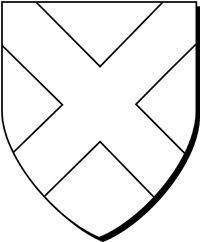
THE CROSS SALTIRE (St. Andrew’s Cross, Crux Decussata) – 1. Formed in the shape of an “X” it is a symbol of martyrdom and humility. 2. It is a symbol of St. Andrew because he is traditionally believed to have died upon a cross saltire. When attending a church dedicated to St. Andrew, you will often find the cross saltire etched into the cornerstone of the church. 3. The cross is the national cross of Scotland. 4. If the cross is colored red, it is known as St. Patrick’s cross. 5. This cross symbolizes St. Alban.

THE SHIELD OF FAITH – 1. A Latin cross stretched over a shield. It symbolizes Christian faith. 2. Shields bearing a cross, anchor and heart symbolize faith, hope and love.

THE SIXTEEN-POINTED CROSS – A cross with each end having four points, like the teeth of a saw. There are sixteen points total.

THE TAU CROSS (Advent, Anticipatory, Crux Commissa, Commissée, Egyptian) – Formed in the shape of a “T”, it is one of the oldest forms of the cross. 1. The tau cross was very popular in Egypt where it was the sign of eternal life. Many Christians who lived in Egypt had this cross, above all others, placed on their burial sites. It is thought by some that this was the sign that the Israelites put on their doorposts so that the angel of death would pass over them (Exodus 12:22). 2. The tau cross is considered the Old Testament cross which Moses raised up in the wilderness and upon which a bronze snake was placed. All who viewed it would not die (Numbers 21:5-9). Scholars look to this cross as a foreshadowing of Jesus Christ being raised up on a cross so that all who called upon Him would not die. In this context, the cross represents prophecy. 3. In liturgical churches, the tau cross is used during Advent.
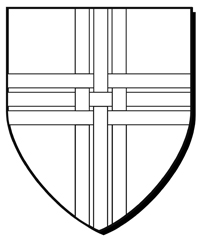
THE TRIPARTED CROSS – This is a cross with three vertical and three horizontal arms that are woven together.

THE CROSS TRIPARTED FLEURÉE – This cross has three vertical arms and three horizontal ones with their endings forming leaves, much like the fleur-de-lys.

THE CROSS OF TRIUMPH (Cross of Victory, Cross of Conquest, Cross Triumphant, Cross and Orb) – This Latin cross resting atop a globe symbolizes the triumph of the Gospel message around the world. The globe usually has a band around it with three points, symbolizing the Trinity. The cross of triumph is sometimes seen in the left hand of Jesus when He is portrayed in His kingly office. It can also be seen on church steeples.
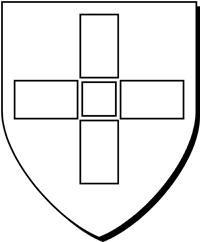
THE CROSS TRON-ONÉE (Cross Dismembered) – Any cross that is cut into five, visibly separate pieces.

THE CROSS VAIR – This is a somewhat thick cross with its ends tapered outwards.

THE CROSS AND VICTORY BANNER – A Latin cross, often thin and narrow, from which a white banner waves. A long, red Latin cross is seen on the banner. This cross symbolizes Jesus as the Lamb of God. This cross is carried by the Lamb of God (Agnus Dei) and also by John the Baptist, who proclaimed the coming of the Lamb of God.
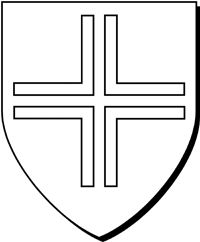
THE CROSS VOIDED – Any cross in which the cross appears transparent, with the background color showing through it.
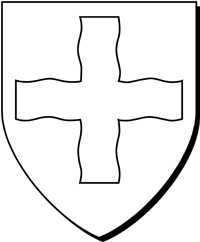
THE CROSS WAVY – This cross is made up of curvy arms.
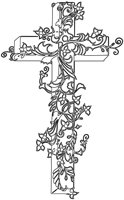
THE CROSS WREATHED – This cross is intertwined with various greenery. 1. If the cross is covered in laurel, it symbolizes victory. 2. If the cross is covered in cypress, it symbolizes immortality. 3. If it is covered in oak, it symbolizes strength. 4. If it is covered in bay leaves, it symbolizes death.